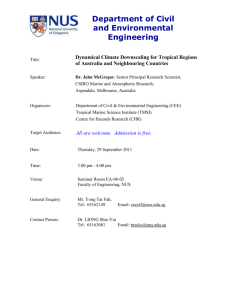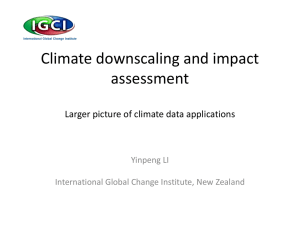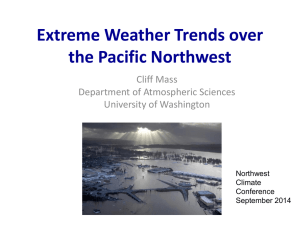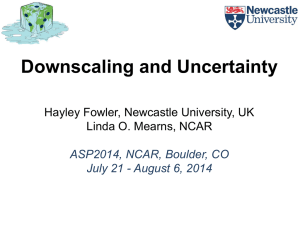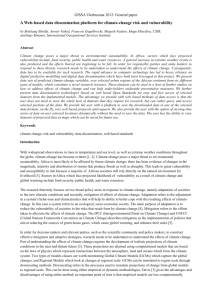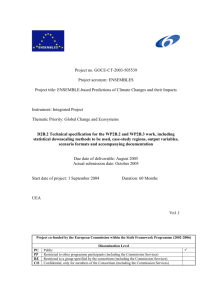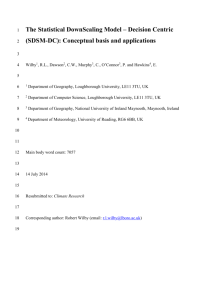Proposal for a Regional Climate Modeling Consortium
advertisement
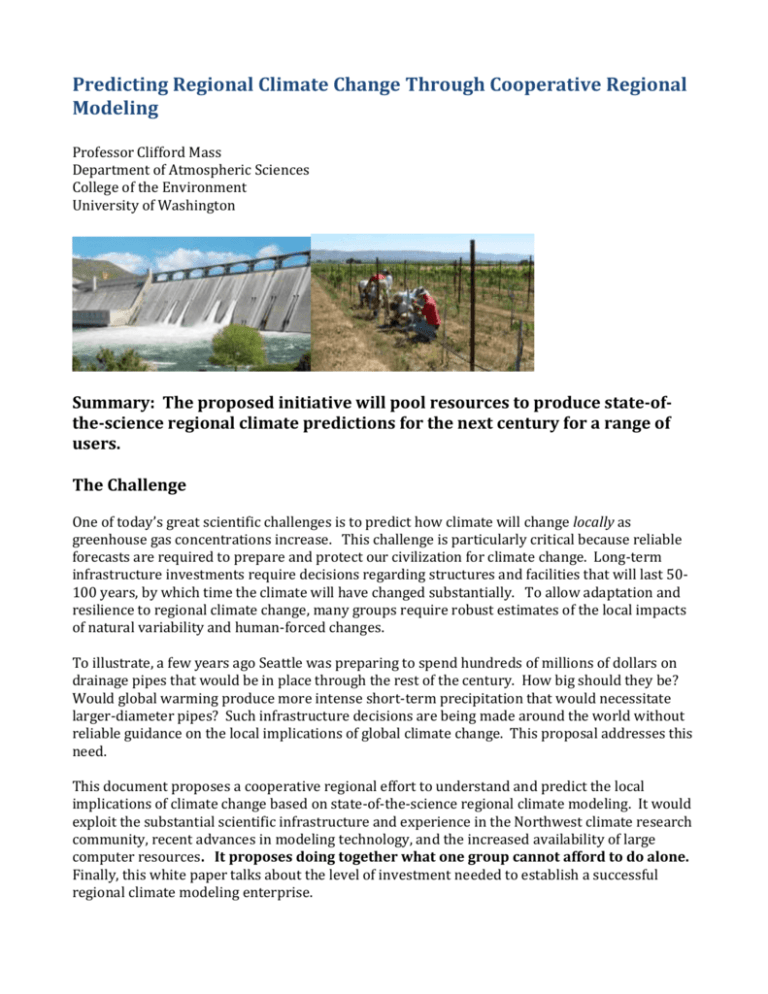
Predicting Regional Climate Change Through Cooperative Regional Modeling Professor Clifford Mass Department of Atmospheric Sciences College of the Environment University of Washington Summary: The proposed initiative will pool resources to produce state-ofthe-science regional climate predictions for the next century for a range of users. The Challenge One of today’s great scientific challenges is to predict how climate will change locally as greenhouse gas concentrations increase. This challenge is particularly critical because reliable forecasts are required to prepare and protect our civilization for climate change. Long-term infrastructure investments require decisions regarding structures and facilities that will last 50100 years, by which time the climate will have changed substantially. To allow adaptation and resilience to regional climate change, many groups require robust estimates of the local impacts of natural variability and human-forced changes. To illustrate, a few years ago Seattle was preparing to spend hundreds of millions of dollars on drainage pipes that would be in place through the rest of the century. How big should they be? Would global warming produce more intense short-term precipitation that would necessitate larger-diameter pipes? Such infrastructure decisions are being made around the world without reliable guidance on the local implications of global climate change. This proposal addresses this need. This document proposes a cooperative regional effort to understand and predict the local implications of climate change based on state-of-the-science regional climate modeling. It would exploit the substantial scientific infrastructure and experience in the Northwest climate research community, recent advances in modeling technology, and the increased availability of large computer resources. It proposes doing together what one group cannot afford to do alone. Finally, this white paper talks about the level of investment needed to establish a successful regional climate modeling enterprise. The Essential Technology: Dynamical Downscaling of Global Climate Models Nearly two-dozen international research groups are now running Global Climate Models (GCMs) driven by a variety of estimates of greenhouse gas emission. These climate models include atmospheric, oceanic, and land surface components and are typically run for 100 to 150 years, covering both a recent historic period and most of the 21st century. Such models are not identical and the diversity of their solutions provides insights into the uncertainties of global climate prediction. Although the foundation of climate prediction, global climate models are typically run at relatively coarse spatial resolution. To illustrate the implications such coarse resolution, the terrain of one such model, the NCAR Coupled Community System Model 4 (CCSM4) is compared to the topography of a typical weather prediction model (WRF) in the figure below. Critical regional features do not appear in the global climate model (e.g., the Cascade and Olympic mountains) and the coastline is poorly resolved, in sharp contrast to the higher resolution WRF model. Terrain map for a relative coarse global climate model (left) and a far higher resolution weather forecasting model (right) A widely applied approach to localizing global climate model projections for climate impact studies is known as “statistical downscaling”. Here global climate model output is used to determine local climate change based on historical relationships. Unfortunately, the value of the resulting climate projections is limited because statistical downscaling considers neither local environmental processes nor how these processes change as the planet warms. A superior approach for determining the local implications of global climate change in complex environments like the Pacific Northwest is the use of regional climate models to dynamically downscale global model output. In this approach, high-resolution regional atmospheric, ocean, and land-surface/hydrologic models are run over a subdomain of a global model. Computer resource demands are more modest than running high-resolution forecasts everywhere. Thus, these regional models take advantage of the global climate models but are run at higher allowing them to consider local and regional features. 2 This dynamical downscaling approach has been developed over the past twenty years, and it is now clear that it is superior to statistical downscaling. Below is an example, showing the change in annual temperatures between today and the 2040s for Washington State for a moderate increase in greenhouse gases (A1B scenario). Statistical downscaling based on global models produces a weak, ill-defined signal, while the dynamically downscaled projection indicates both greater warming and the profound effects of local terrain. Dramatically, the dynamically downscaled run suggests large warming to the east of the Cascades that is absent in the statistical approach. Temperature change projected for the 2040s from statistical downscaling of global climate models (GCMs), dynamical downscaling of GCMs, and the difference between the two methods. To illustrate some initial tests, changes in near-surface temperature computed from a global model are compared to those from a regional model in the figure presented below (from Salathé et al. 2010). The left panel shows the simulated change in winter surface air temperature between 1995 and 2050 from the ECHAM-5 global climate model (GCM). Temperatures are warming, but the patterns are unrealistically smooth due to the poor representation of the actual terrain. In contrast, the right panel shows the results obtained by dynamically downscaling the global model output using a high-resolution regional model (MM5). The results are substantially more realistic, with major impacts from regional terrain, including bands of enhanced warming caused by melting snow on the slopes of major topographic features. 3 GCM WRF Global models (left panel) simulate an artificially smooth pattern of warming in the Northwest, whereas regional models (right panel) capture the effects of terrain on warming. Both maps show the change in Dec-Feb minimum temperatures from 1995-2050, based on the ECHAM-5 GCM and a medium (A1b) greenhouse gas scenario Dynamical downscaling can extend beyond regional atmospheric models by including regional ocean, hydrologic, air quality, and land-surface models as well. Substantial exploratory work has already been completed over the western U.S. using this multi-model approach for several regional climate simulations. For example, an ECHAM-5 global model simulation for 1970-2070 was used to drive a high-resolution weather forecasting model (MM5) over the same period, which in turn provided input fields for the VIC hydrological model. The results of this coupled simulation suggest an increase in flood risk during the 21st century. Finally, the projections produced by dynamical downscaling of global climate models can be further improved using statistical techniques (know as statistical postprocessing). The Northwest Possesses Substantial Experience in the Relevant Technologies Significant exploration of the potential of regional climate modeling over the western U.S. has already taken place, including programs at the University of Washington, Washington State University, Oregon State University, and the Pacific Northwest National Laboratory. These regional climate-modeling experiments have simulated the current climate of western North America and provide a limited number of regional projections on time scales of decades to a century. This work has developed and validated the basic modeling approach described above, including the linking of the WRF regional atmospheric model to land, ocean, and air quality models. This initial work has facilitated climate impacts studies for some local groups, ranging from Seattle City Light to the U.S. Forest Service. This work should be viewed as exploratory: it has not included a sufficiently large number of regional climate simulations for estimating forecast uncertainties, and lack the sophisticated statistical post-processing required to provide robust probabilistic projections of 21st century regional climate change. 4 The coupling of the WRF atmospheric model with the ROMS coastal ocean model has already been completed successfully for contemporary periods. Why is the Potential So Great Now to Provide Useful Regional Climate Forecasts? The potential exists today to create robust regional climate predictions based on regional dynamical downscaling of global climate models. This is true for a number of reasons: 1. Large numbers of global climate models are now available, many through the international CMIP-5 effort, which allows exploration of the uncertainty in large-scale circulation changes under global warming. 2. Regional climate models have improved dramatically. 3. The computer power is now available for running sufficiently high-resolution regional models. 4. Improved approaches for statistically enhancing the regional climate runs have become available. 5. The technology of combining atmospheric, hydrological, ocean, and air quality models has been perfected. Building a Regional Climate Prediction Effort The proposed effort will support the creation of actionable, state-of-the-science projections of the regional implications of climate change. The key technology will be the dynamical downscaling of global climate models using high-resolution regional atmospheric, hydrologic, oceanic and air quality models as well as sophisticated statistical post-processing. Although the Pacific Northwest will be the first region considered, once developed, the science and technology will be applicable for any location around the globe. Important activities of the proposed project include: Collection of a large number of global climate model simulations to ensure that the uncertainties in large-scale climate forcing are defined and evaluated. Of great significance and value are regional climate signals that are shared by many models and simulations. Dynamically downscaling the global model simulations over the western U.S. We expect to use the Weather Research and Forecasting (WRF) system as our primary regional atmospheric 5 model using 12-km grid spacing over the region, but it is certainly possible to use others. Each downscaled simulation will encompass the 120-year period from 1980 to 2100. The regional climate simulations will include atmospheric, land surface, ocean, air quality and hydrologic simulations driven by WRF. Post-processing of the regional model output. All models have systematic biases, and there is inevitably a lack of spread using the limited number of global model simulations available. Possible post-processing steps include the removal of known systematic biases, weighting the simulations as a function of the fidelity of each model to observations during the contemporary period, and creating probabilities based on the variability of the climate models. Although the initial work of this project could be completed in 2-3 years with sufficient support, the proposed effort would ideally be an ongoing project, with continuous improvement of the regional projections as the science/technology inevitably improves and tailoring the results to the needs of the supporting stakeholders. Furthermore, this effort could extend to additional regions over time or transfer the technologies to a private-sector spin-off company. Regional model simulations with 12-km grid spacing are capable of predicting key regional scale features such as heavy precipitation on the windward side of the Olympics and rain shadowing on the northeast side. The results from the simulations will be made available to the UW Climate Impacts Group, the USDA Climate Change Resource Center and the Oregon Climate Change Research Institute (OCCRI) as well as the supporting stakeholders and their designees. A Multi-Institutional Effort The key approach of this initiative is the combination of the resources of local groups that require actionable information of regional climate change in the Northwest. Such resources are both financial and intellectual, allowing the group to do what each member could not do individually. There is a successful prototype for such regional cooperative effort: the Northwest Regional Modeling Consortium that combines resources from many regional stakeholders to provide state-of-the-science weather prediction to the Northwest (http://www.atmos.washington.edu/cliff/consortium.html) The regional climate modeling effort would include modeling groups at the University of Washington, Washington State, PNNL, and Oregon State as well as dedicated climate impacts groups in Washington and Oregon. The University of Washington will lead the atmospheric, hydrologic and ocean simulations, while Washington State University will play a central role in 6 the use of the downscaled runs for air quality, wildfire, agriculture and smoke-related issues. The Pacific Northwest National Laboratory would bring considerable experience in regional climate modeling, particularly regarding the impacts of aerosols and implications for regional drought. The Oregon Climate Change Research Institute (OCCRI) has explored the use of personal computers for running intermediate-resolution (25-km) climate simulations over a limited domain, and these runs will be evaluated along with the higher resolution climate simulations created under this effort. The Northwest possesses a substantial base of experience and knowledge in regional climate modeling and application; the cooperation and joint efforts of these groups will foster rapid progress. Computer Resources The regional climate simulations undertaken for this project will require substantial computer resources. Addition computer resources will be required for the ocean, hydrological, and air chemistry components of the project. The necessary resources can be acquired by purchasing a cluster or by purchasing part of a preexisting system such as the UW Hyak cluster. The estimated cost of the required hardware is approximately $120K based on current prices. In addition, there would be modest annual costs for technical support for the acquired cluster (approximately $10K per year). Another possibility is to purchase access to commercial resources, such as those provided by Amazon, Google, or a range of private-sector vendors. It also may be possible secure computer resources from a national supercomputer center, such as those run by the Department of Energy, NASA, NOAA or NSF. Personnel and Other Costs It is estimated that a minimum of at least three full time individuals with suitable technical/scientific backgrounds will be required to initiate the proposed regional climate simulation effort. Such personnel, support staff, and the required computer resources would require a minimum $300,000-$500,0000 per year to begin this work. Additional resources would allow more rapid and extensive progress. It is expected that it would take roughly three years to produce the initial collection of regional climate simulations/projections. Summary Remarks Society today has a pressing need to understand the regional implications of global climate change. In many ways, this is one the greatest scientific and practical problems of our time and is needed for making important decisions related to natural resources, adaptation, and environmental vulnerability. The coordinated effort necessary for developing critically needed regional climate predictions a substantial effort. By pooling resources, regional entities that require robust regional climate predictions can secure guidance than no individual group could afford. 7
